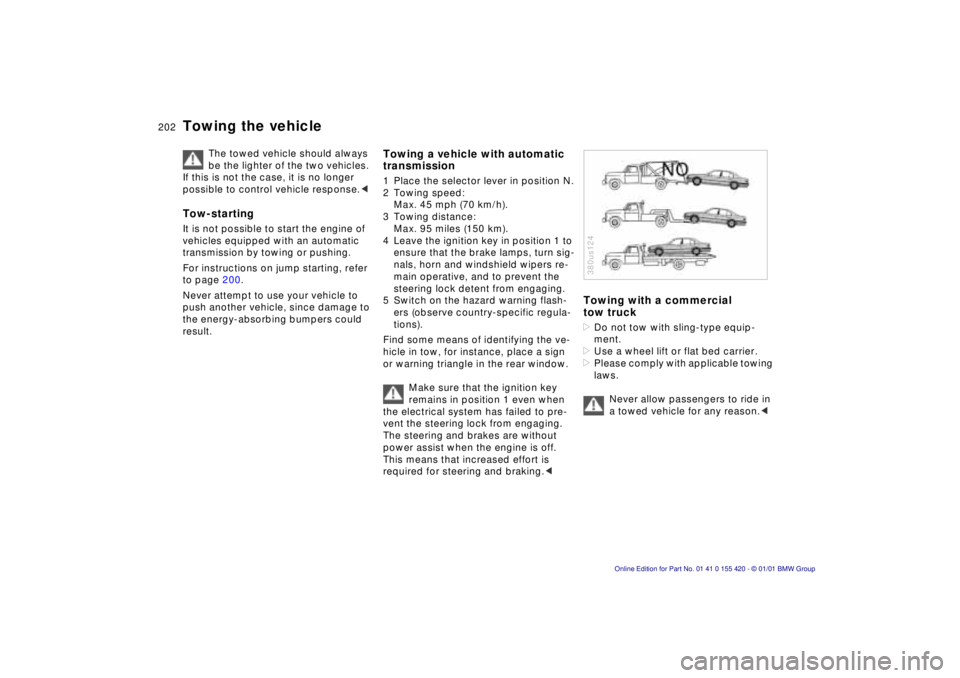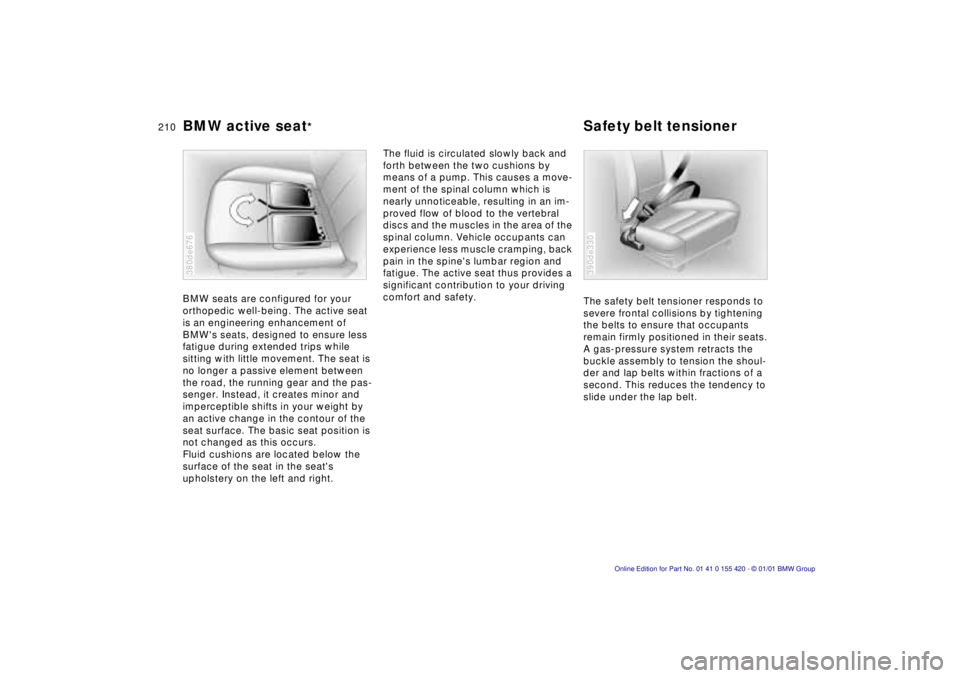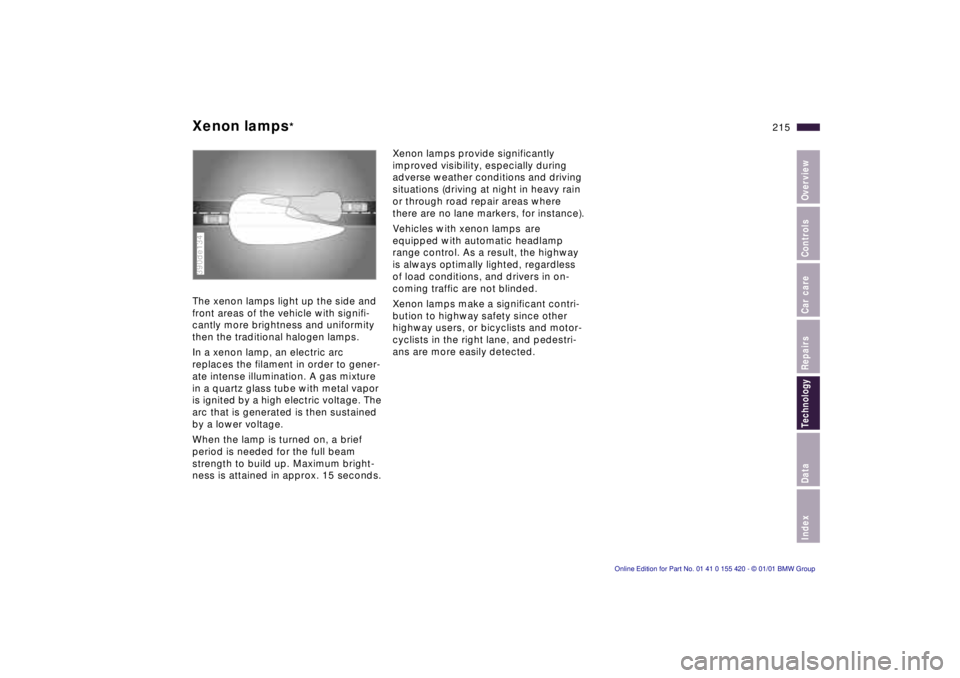Page 202 of 238

202nTowing the vehicle
The towed vehicle should always
be the lighter of the two vehicles.
If this is not the case, it is no longer
possible to control vehicle response. <
Tow-starting
It is not possible to start the engine of
vehicles equipped with an automatic
transmission by towing or pushing.
For instructions on jump starting, refer
to page 200.
Never attempt to use your vehicle to
push another vehicle, since damage to
the energy-absorbing bumpers could
result.
Towing a vehicle with automatic
transmission
1 Place the selector lever in position N.
2 Towing speed: Max. 45 mph (70 km/h).
3 Towing distance: Max. 95 miles (150 km).
4 Leave the ignition key in position 1 to ensure that the brake lamps, turn sig-
nals, horn and windshield wipers re-
main operative, and to prevent the
steering lock detent from engaging.
5 Switch on the hazard warning flash- ers (observe country-specific regula-
tions).
Find some means of identifying the ve-
hicle in tow, for instance, place a sign
or warning triangle in the rear window.
Make sure that the ignition key
remains in position 1 even when
the electrical system has failed to pre-
vent the steering lock from engaging.
The steering and brakes are without
power assist when the engine is off.
This means that increased effort is
required for steering and braking. <
Towing with a commercial
tow truck
> Do not tow with sling-type equip-
ment.
> Use a wheel lift or flat bed carrier.
> Please comply with applicable towing
laws.
Never allow passengers to ride in
a towed vehicle for any reason. <
380us124
Page 208 of 238

208nASC+T/DSC*
Precision sensors monitor the number
of revolutions of the wheels. When
equipped with DSC, they also monitor
steering angle, lateral acceleration,
brake pressure and the movement of
the vehicle around its vertical axis.
If differences in the wheel speeds
occur, the system counteracts the dan-
ger of wheelspin by reducing torque. If
necessary, the system also responds
with additional brake applications at the
rear wheels, and at all 4 wheels with
DSC.
In addition, DSC permanently monitors
the vehicle's current operating condi-
tion and compares it with an ideal con-
dition that is calculated from the sen-
sor's signals. If deviations from this
occur (understeering or oversteering,
for instance), DSC can stabilize the
vehicle in the fraction of a second by
reducing engine output and with the
assistance of braking intervention at in-
dividual wheels. As a result, dangerous
skids can be prevented even as they
are just beginning. You may need some time to become
accustomed to this system intervention.
However, it guarantees optimum drive
force and driving stability.
The braking intervention may be
accompanied by a certain degree of
noise.
Page 210 of 238

210nBMW active seat*Safety belt tensioner
BMW seats are configured for your
orthopedic well-being. The active seat
is an engineering enhancement of
BMW's seats, designed to ensure less
fatigue during extended trips while
sitting with little movement. The seat is
no longer a passive element between
the road, the running gear and the pas-
senger. Instead, it creates minor and
imperceptible shifts in your weight by
an active change in the contour of the
seat surface. The basic seat position is
not changed as this occurs.
Fluid cushions are located below the
surface of the seat in the seat's
upholstery on the left and right.
380de676
The fluid is circulated slowly back and
forth between the two cushions by
means of a pump. This causes a move-
ment of the spinal column which is
nearly unnoticeable, resulting in an im-
proved flow of blood to the vertebral
discs and the muscles in the area of the
spinal column. Vehicle occupants can
experience less muscle cramping, back
pain in the spine's lumbar region and
fatigue. The active seat thus provides a
significant contribution to your driving
comfort and safety.
The safety belt tensioner responds to
severe frontal collisions by tightening
the belts to ensure that occupants
remain firmly positioned in their seats.
A gas-pressure system retracts the
buckle assembly to tension the shoul-
der and lap belts within fractions of a
second. This reduces the tendency to
slide under the lap belt.
390de330
Page 211 of 238

Index
Data
Technology
Repairs
Car care
Controls
Overview
211nDSP sound system*Mirrors with automatic dimmer*
The DSP professional premium sound
system features a special amplifier
combined with Digital Sound Process-
ing (DSP) and integrated speakers to
surround you with crisp, true-to-life
sound reproduction.
The speaker system's subwoofers,
woofers, midrange speakers and tweet-
ers furnish you with an impressively full-
bodied listening experience. The indi-
vidual components are oriented so as
to produce the aural sensation that you
would experience facing the stage in a
concert hall. The system also automati-
cally adjusts the bass and treble set-
tings to compensate for changes in vol-
ume and vehicle speed.
390de109
The interior and exterior mirrors with
automatic dimming feature reduce the
glare from following traffic by adapting
the intensity of the reflected images to
correspond to levels of light registered
by the unit's sensors. The mirrors revert
to their undimmed setting as soon as
the light source disappears.
One sensor is mounted on the front
of the interior mirror housing and is
designed to monitor light levels in the
area immediately forward of the vehicle.
A second sensor is integrated within
the mirror's glass.
390de113
The electronic control system operates
by comparing the respective levels of
luminous intensity in front of and behind
the car. The difference provides the
basic parameter used to modulate an
electrical current and induce chemical
changes in a semisolid layer incorpora-
ted in the lens.
The semisolid reacts chemically to this
electrical current, thus providing infi-
nitely-variable dimming of the mirror
(electrochromic technology).
As a result, it is no longer necessary
to dim the mirror manually, and the
driver can maintain full concentration
on traffic.
Page 215 of 238

Index
Data
Technology
Repairs
Car care
Controls
Overview
215nXenon lamps*
The xenon lamps light up the side and
front areas of the vehicle with signifi-
cantly more brightness and uniformity
then the traditional halogen lamps.
In a xenon lamp, an electric arc
replaces the filament in order to gener-
ate intense illumination. A gas mixture
in a quartz glass tube with metal vapor
is ignited by a high electric voltage. The
arc that is generated is then sustained
by a lower voltage.
When the lamp is turned on, a brief
period is needed for the full beam
strength to build up. Maximum bright-
ness is attained in approx. 15 seconds.
390de134
Xenon lamps provide significantly
improved visibility, especially during
adverse weather conditions and driving
situations (driving at night in heavy rain
or through road repair areas where
there are no lane markers, for instance).
Vehicles with xenon lamps
are
equipped with automatic headlamp
range control. As a result, the highway
is always optimally lighted, regardless
of load conditions, and drivers in on-
coming traffic are not blinded.
Xenon lamps make a significant contri-
bution to highway safety since other
highway users, or bicyclists and motor-
cyclists in the right lane, and pedestri-
ans are more easily detected.
Page 236 of 238
So that you will have important
specifications available when you
stop to refuel, we recommend that
you supplement this table with data
which apply to your vehicle. Fuel
Engine oil
The space between the two marks on
the dipstick corresponds to approx.
1.1 US quarts (1 liter).
Designation Premium Unleaded Gasoline
AKI: minimum 91
Quality
Tire inflation pressures Summer Winter
front rear front rear
4 persons
5 persons or 4 plus luggage
RefuelingBMW recommends Castrol